Étiquette : Guido Cantelli
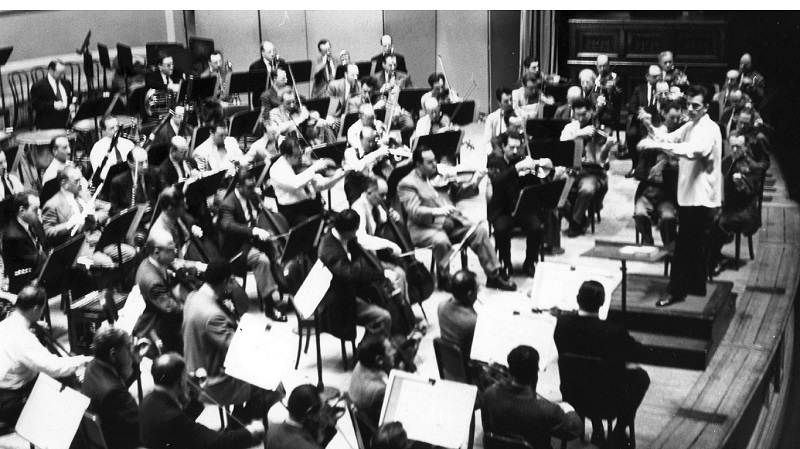
Tchaïkovsky Roméo & Juliet NBC SO
Carnegie Hall – February 2, 1952
Respighi I Pini di Roma NYPO
Carnegie Hall – March 27, 1955
Source: Bande/Tape – 2 pistes 19cm/s / 2tracks 7.5 ips
Ces deux œuvres orchestrales brillantes mettent en avant le dynamisme, le sens de la construction dramatique ainsi que la finesse expressive de Guido Cantelli dans une veine interprétative dans la lignée de Toscanini, sans la banalité que l‘on perçoit avec les interprètes qui recherchent le spectaculaire. Cantelli évite également la dureté de Toscanini dans son enregistrement de 1946 de l’œuvre de Tchaïkovski.
Cantelli avait déjà joué l’œuvre de Tchaïkovski avec le NBC SO lors de son deuxième concert avec cet orchestre (22 janvier 1949).
Pour l’œuvre de Respighi, que Cantelli donne pour la première et la dernière fois avec le NYPO lors de cette série de concerts (24, 25 & 27 mars 1955), l’orchestre a fait appel à des musiciens supplémentaires, dont le pianiste Leonid Hambro et l’organiste Claire Coci.
Le concert du 27 mars 1955 était le dernier de Cantelli avant la tournée transcontinentale de 31 concerts du NYPO du 18 Avril au 22 Mai qu’il a co-dirigée avec Dimitri Mitropoulos. Cantelli n’a pas redonné cette œuvre très populaire de Respighi, alors que le répertoire choisi par lui était très restreint: lors des 14 concerts qu’il a dirigés lors de cette tournée, il a joué 10 fois la Première de Brahms, 7 fois les Tableaux d’une Exposition de Moussorgski, et 6 fois la Suite n°2 de Daphnis & Chloé de Ravel, ce que dit-on, l’orchestre n’a pas apprécié sur une période aussi courte.
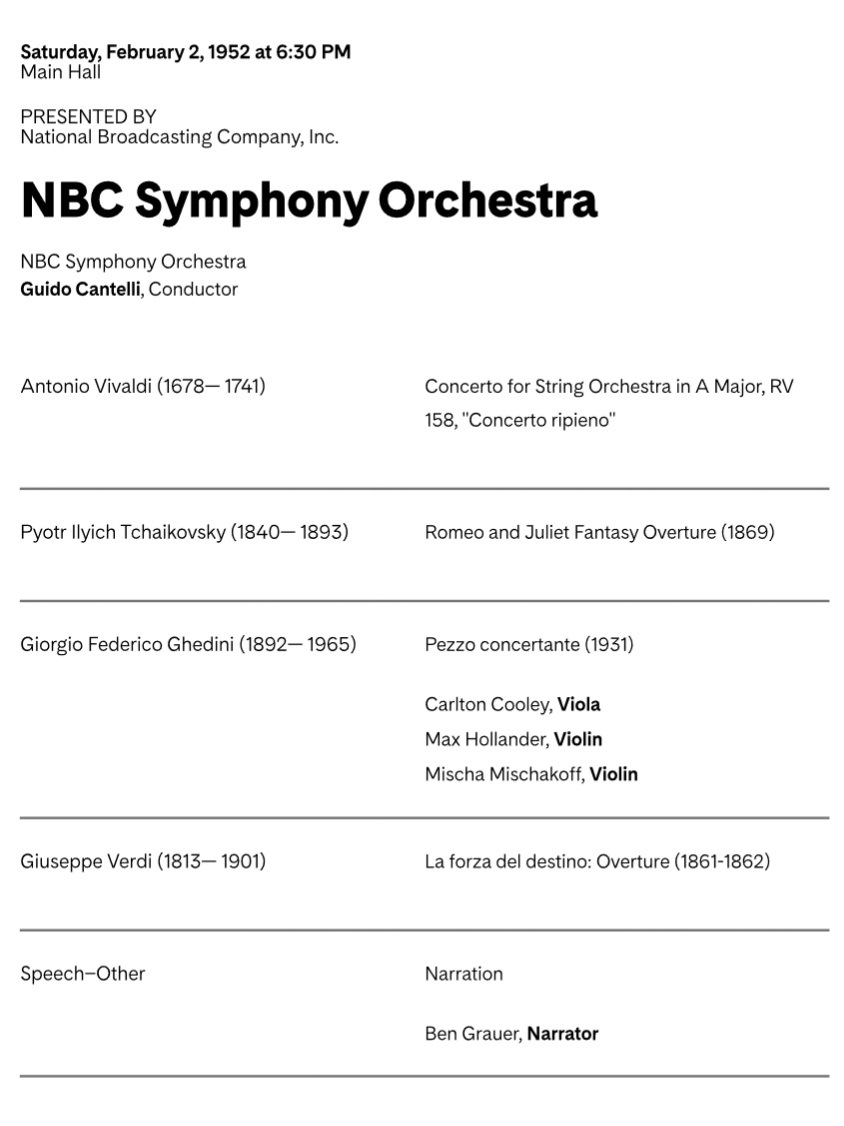
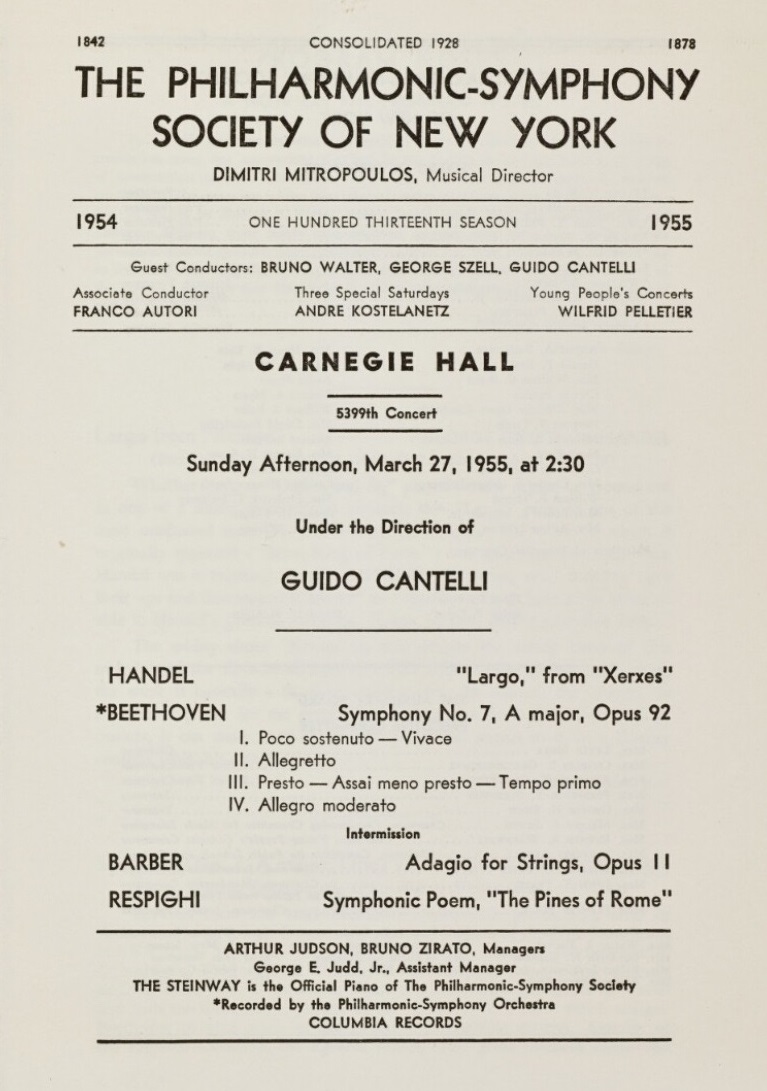
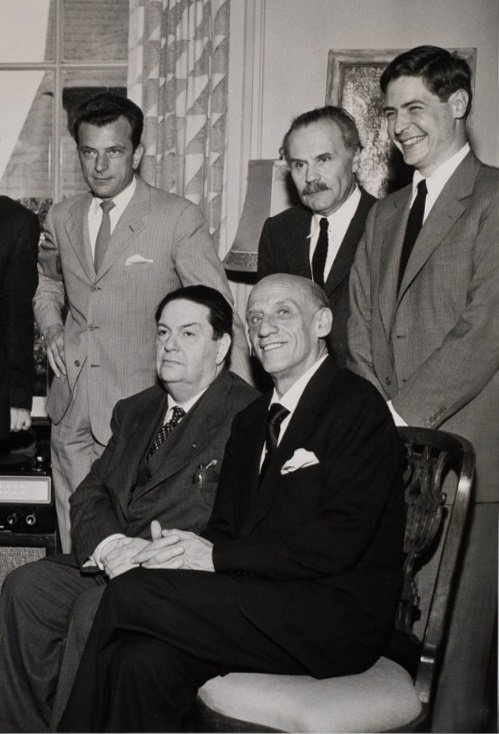
Guido Cantelli Darius Milhaud Dimitri Mitropoulos Gastone Usigli George Judd Jr NYPO Tour San Francisco May 1955
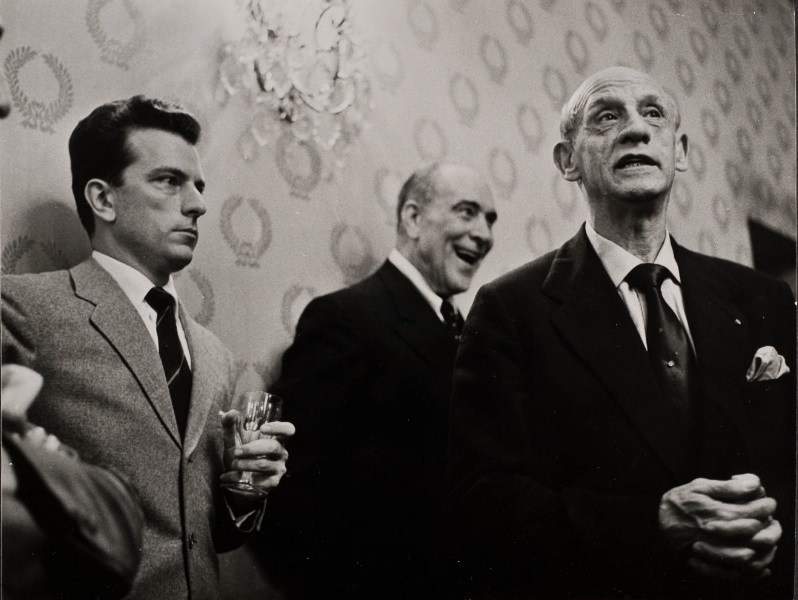
Guido Cantelli, Bruno Zirato & Dimitri Mitropoulos NYPO Tour 1955
These two brilliant orchestral works showcase Guido Cantelli’s dynamism, sense of dramatic construction and expressive finesse in an interpretative vein in the tradition of Toscanini, without the banality one perceives with performers who seek the spectacular. Cantelli also avoids Toscanini’s tautness in his 1946 recording of Tchaikovsky’s work.
Cantelli had already performed Tchaikovsky’s work with the NBC SO in his second concert with this orchestra (January 22, 1949).
For Respighi’s work, which Cantelli performs for the first and last time with the NYPO during this series of concerts (March 24, 25 & 27 1955), the orchestra called on additional musicians, including pianist Leonid Hambro and organist Claire Coci.
The March 27, 1955 concert was Cantelli’s last before the 31-concert transcontinental tour of the NYPO, which he co-conducted with Dimitri Mitropoulos from April 18 to May 22. Cantelli did not play again this very popular work by Respighi, even though the repertoire he had chosen was very limited: in the 14 concerts he conducted on this tour, he conducted Brahms’ First 10 times, Moussorgsky’s Pictures at an Exhibition 7 times, and Ravel’s Suite n°2 from Daphnis & Chloé 6 times, which, as was said, the orchestra did not appreciate in such a short space of time.
Les liens de téléchargement sont dans le premier commentaire. The download links are in the first comment
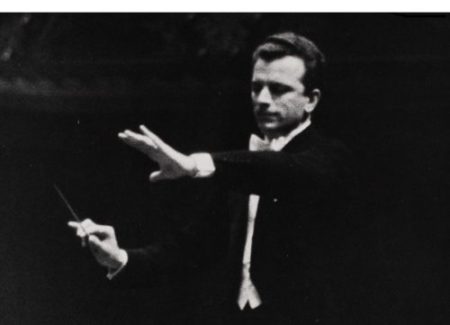
Guido Cantelli – Beethoven
Concerto n°3 Op.37 – Rudolf Firkušný, piano (Steinway) NYPO
Carnegie Hall – March 13, 1955
__________
Symphony n°1 Op. 21 – NBC SO
Carnegie Hall – January 10, 1954
Source: Bande/Tape 19 cm/s / 7.5 ips
Au cours des années cinquante, Firkušný était invité tous les ans à jouer avec le NYPO. En 1955, le choix se porta sur ce concerto de Beethoven, sous la direction de Cantelli. Les critiques du concert du 10 mars ont souligné la qualité de l’interprétation et l’entente entre le soliste et le chef.
Musical America: M. Firkušný et le chef d’orchestre étaient en parfait accord, ce qui a donné lieu à une interprétation bien intégrée. Bien qu’il ait semblé tendu, le pianiste a joué avec sa maîtrise technique habituelle et son tempérament sensible. Le soliste et l’orchestre ont apporté la même éloquence à la musique ».
New York Times: Dans le concerto de Beethoven, M. Cantelli s’est révélé être le plus sympathique et le plus attentif des accompagnateurs. Il a très bien travaillé avec M. Firkušný, et c’était un plaisir d’écouter les attaques et les relâchements tranchants. Le pianiste a joué magnifiquement, en prodiguant des détails d’écriture, en épurant ses phrases et en exécutant l’écriture avec netteté. Ce fut une interprétation élégante de la part de tous les participants, qui a fait ressortir la force et la poésie de la musique sans jamais commettre l’erreur de concevoir le Concerto en do mineur comme l' »Empereur ».
Cantelli a très peu dirigé la Première Symphonie de Beethoven. Son interprétation avec le NBC SO est une réussite et la source utilisée (une bande magnétique) est meilleure que celles des éditions précédentes.
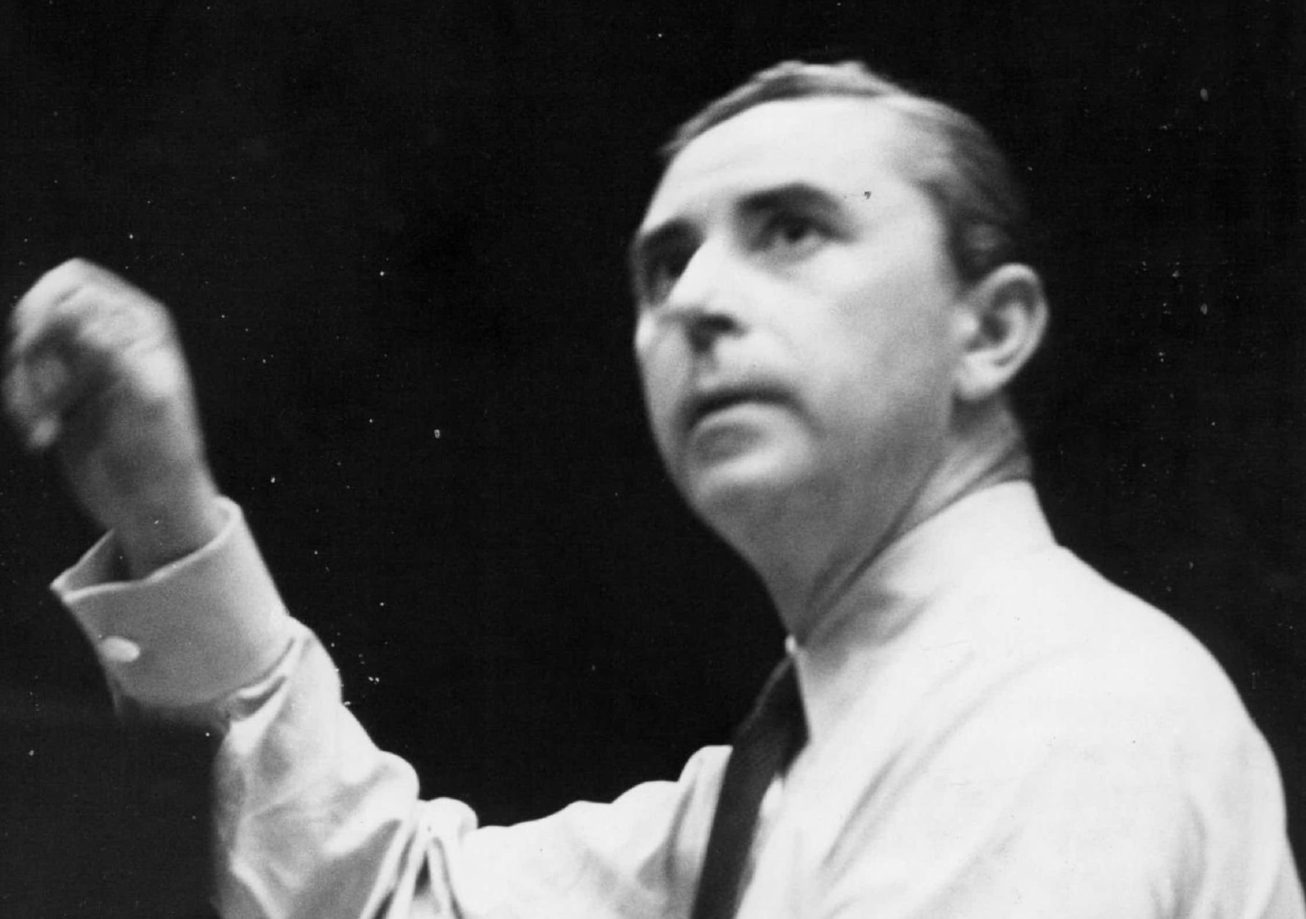
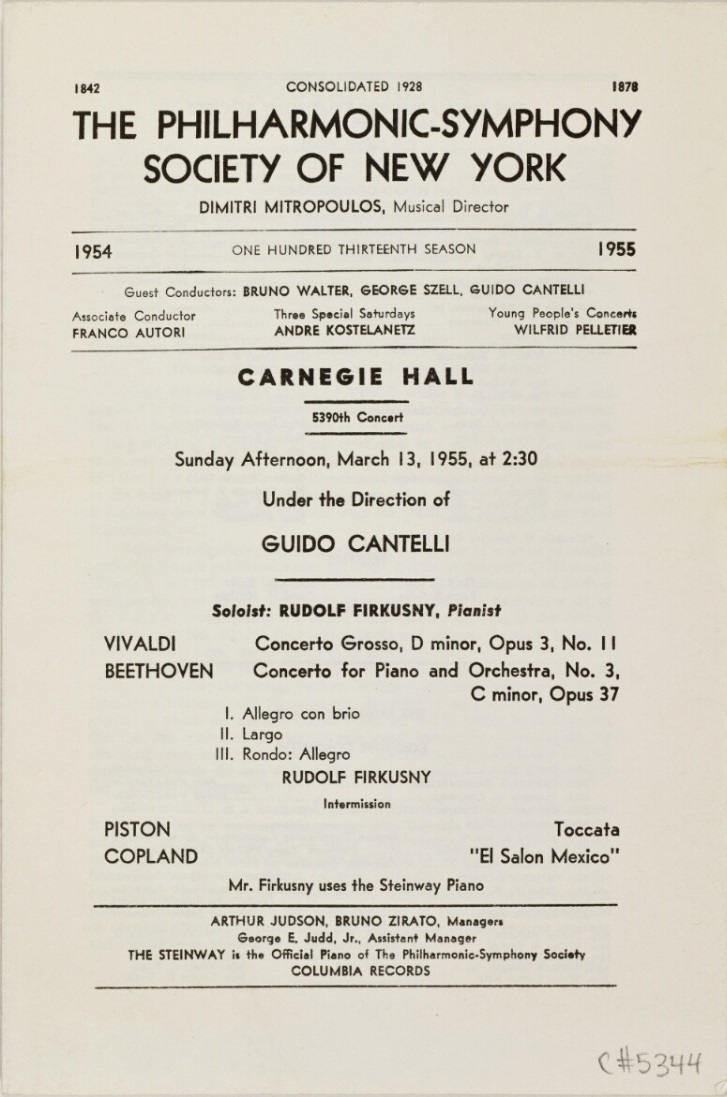
During the 1950s, Firkušný was invited every year to play with the NYPO. In 1955, the choice fell on this Beethoven concerto, conducted by Cantelli. Reviews of the March 10 concert praised the quality of the interpretation and the understanding between soloist and conductor.
Musical America: ‘Mr. Firkušný and the conductor saw eye to eye, and the result was a well-integrated performance. Although he seemed tense, the pianist played with his accustomed technical mastery and sensitivity of temperament. Soloist and orchestra brought equal eloquence to the music’.
New York Times: ‘In the Beethoven concerto, Mr. Cantelli proved to be the most sympathetic and careful of accompanists. He worked exceedingly well with Mr. Firkušný, and it was a pleasure to listen to the sharp attacks and releases. The pianist played beautifully, lavishing detail upon the writing, purling his phrases, bringing clean-cut execution of the writing. It was an elegant performance from all concerned, one that brought out the strength and poetry of the music without ever making the mistake of conceiving the C minor Concerto as the ‘Emperor’ ‘.
Cantelli has rarely conducted Beethoven’s First Symphony. His performance with the NBC SO is a success, and the source used (a magnetic tape) is better than those for previous editions.
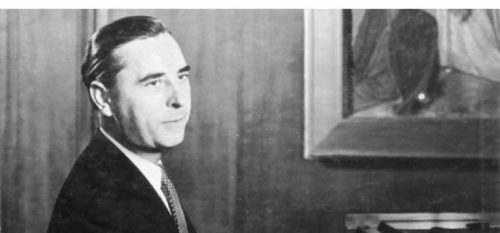
Rudolf Firkušný, piano (Steinway) – Guido Cantelli – New York Philharmonic (NYPO)
Carnegie Hall – April 8, 1956
Source: Bande/Tape 19 cm/s / 7.5 ips
Cette très belle interprétation du Premier Concerto de Brahms provient du dernier concert de Guido Cantelli à New-York.
Le pianiste avait beaucoup d’affinités avec le chef, ainsi qu’il l’a relaté dans une interview:
‘Cantelli était toujours extrêmement bien préparé et dirigeait la plupart des œuvres du répertoire de mémoire. J’ai eu énormément de plaisir à travailler avec lui, car nous avons ressenti une certaine affinité dans nos idées musicales. De plus, sa préparation scrupuleuse de l’orchestre rendait la coopération tout à fait idéale. Les concerts ne pouvaient que bien se passer après sa préparation minutieuse lors des répétitions. Bien qu’il soit exigeant et jeune, il était très respecté par les membres de l’orchestre et, je pense, très apprécié en tant que personne. J’ai été étonné par son évolution régulière et son processus de maturation. Notre dernière prestation a montré que son attitude à l’égard de l’orchestre s’était quelque peu adoucie, sans pour autant faire de concessions sur le plan des exigences’.
Les propos de Firkušný se reflètent bien dans des critiques de cette interprétation parues à l’époque:
Louis Biancolli (World Telegram and Sun) : ‘Avec Guido Cantelli dirigeant l’un de ses meilleurs accompagnements à ce jour, l’interprétation a été passionnante, depuis la force tragique et sinistre des accords d’ouverture jusqu’à la dernière explosion jubilatoire du Finale. M. Firkušný était dans une veine exaltante. Il a apporté une vigueur saisissante aux passages héroïques, donnant à la ligne soliste l’avantage d’un son fort et solide qui n’a jamais perdu de sa résonance. Dans les moments calmes également, il s’est montré un véritable poète, mêlant sonorités douces et sentiments tendres, inscrivant des phrases plutôt que des vers et laissant le plaisir de lire – et de penser – librement entre les lignes……. Depuis dix-huit ans que j’entends M. Firkušný jouer, je l’ai vu devenir l’une des personnalités les plus marquantes du clavier. Cette personnalité n’a jamais été aussi imposante qu’hier soir. Par leur tempérament et leur style, le concerto et M. Firkušný semblent avoir été conçus l’un pour l’autre, tant l’unité de la vision poétique est étroite.’
Howard Taubman (New York Times) : Rudolf Firkušný a donné un coup de fouet au concert philharmonique donné hier soir au Carnegie Hall avec une interprétation passionnante du Concerto en ré mineur de Brahms. Pianiste de tempérament, il a apporté poésie et tension dramatique à une œuvre qui exige un mélange de tendresse et de passion.
Il est aujourd’hui un pianiste majeur, l’un des meilleurs de la profession. Son interprétation de Brahms hier soir en est une nouvelle preuve. Il l’a fait dans la grande tradition. Dans le premier mouvement, qui est un drame puissant en soi, M. Firkušný a joué avec une profondeur et une solidité de ton, avec une compréhension de l’idiome romantique particulier de Brahms et avec une vitalité qui a parcouru toute son interprétation. Et même, à un moment donné, une série d’accords fortissimo était d’une intensité presque choquante. Mais le charme n’a pas été rompu : c’est comme si le pianiste secouait l’orchestre et le public pour les amener à un rapport plus concentré.
Guido Cantelli, qui entamait sa dernière semaine en tant que chef invité, a bénéficié d’un bien meilleur accompagnement de la part de l’orchestre que lorsqu’il avait fait appel cette saison, à deux reprises, à des pianistes solistes. Le mouvement lent, avec son chant soutenu et méditatif, était particulièrement envoûtant, et M. Firkušný s’y est montré un poète sensible, jouant avec une grande richesse de nuances.
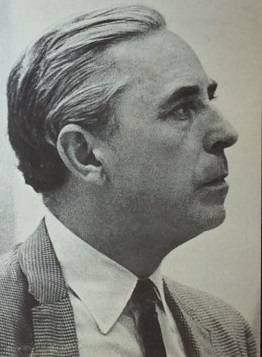
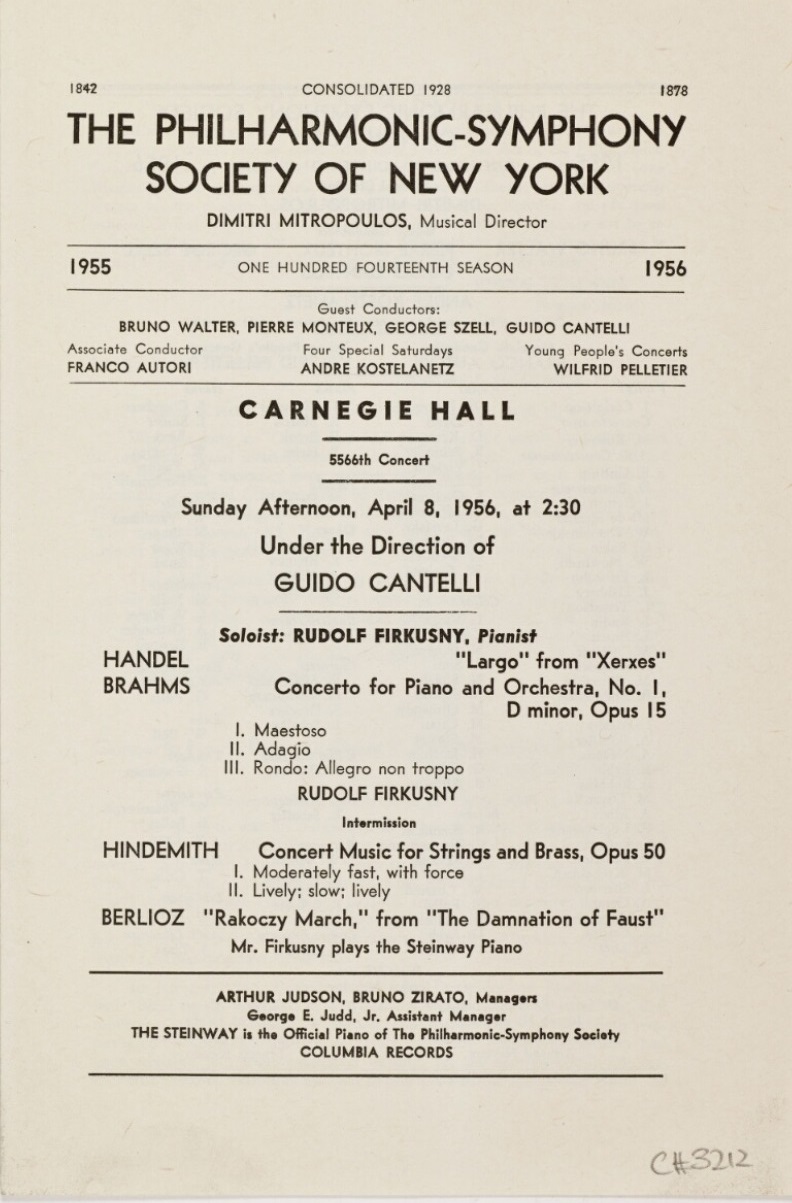
This beautiful performance of Brahms’ First Piano Concerto comes from Guido Cantelli’s last concert in New York.
The pianist had a great affinity with the conductor, as he recounted in an interview:
‘Cantelli was always extremely well prepared, conducting most of the standard repertoire from memory. I enjoyed working with him enormously as we felt a certain affinity in our musical ideas. Also, his scrupulous preparation of the orchestra made the cooperation quite ideal. The performances had to go well after his careful preparation in rehearsals. Although he was demanding and young, he was greatly respected by the orchestra members and I think very much liked as a person. I was amazed by his steady growth and maturing process. Our last performance showed that his attitude towards the orchestra had mellowed somewhat, yet without any concessions in his demands’.
Firkušný’s words are well reflected in reviews of this interpretation published at the time:
Louis Biancolli (World Telegram and Sun): ‘With Guido Cantelli conducting one of his finest accompaniments to date, the performance was a stirring one from the grim tragic strength of the opening chords to the jubilant last flourish of the Finale. Mr. Firkušný was in exalted vein. He brought arresting vigour to the heroic passages, giving the solo line the benefit of a strong, solid tone that never lost resonance. Also in the quiet places he was the true poet, mixing soft-spun sound with tender feeling, inscribing phrases instead of verses and allowing one the pleasure of reading – and thinking – freely between the lines…… In the eighteen years I have heard Mr. Firkušný play, I have watched il grow into one of the most commanding personalities of the keyboard. That personality was never so commanding as it was last night. In temperament and style, the Concerto and Mr. Firkušný seemed to have been intended for one another, so close was the unity of poetic vision.
Howard Taubman (New York Times): ‘Rudolf Firkušný gave a lift to the last night’s Philharmonic concert given at Carnegie Hall with an exciting performance of Brahms’ D minor Concerto. He is a pianist of temperament, and he brought poetry and dramatic tension to a work that demands a commingling of tenderness and passion.
He is now a major pianist, one of the best in the profession. His performance of Brahms last night was further evidence of this. It was in the grand manner. In the first movement, which is a powerful drama in itself, Mr. Firkušný played with depth and solidity of tone, with a grasp of Brahms’ special romantic idiom and with a vitality that pulsed through his entire interpretation. Indeed, at one point, a series of fortissimo chords was almost schocking in its intensity. But, the spell was not brocken: it is as if the pianist were jolting orchestra and audience into more concentrated rapport.
Guido Cantelli, who began his final week as guest conductor, got a much better accompaniment from the orchestra than he had on two previous occasions this season when he had piano soloists. The slow movement, with its sustained, meditative song was especially enamoring, and here Mr. Firkusny was the sensitive poet, playing with a wealth of nuance.’

Guido Cantelli – New York Philharmonic (NYPO)
Carnegie Hall – March 29, 1953
Source: Bande/Tape 19 cm/s / 7.5 ips
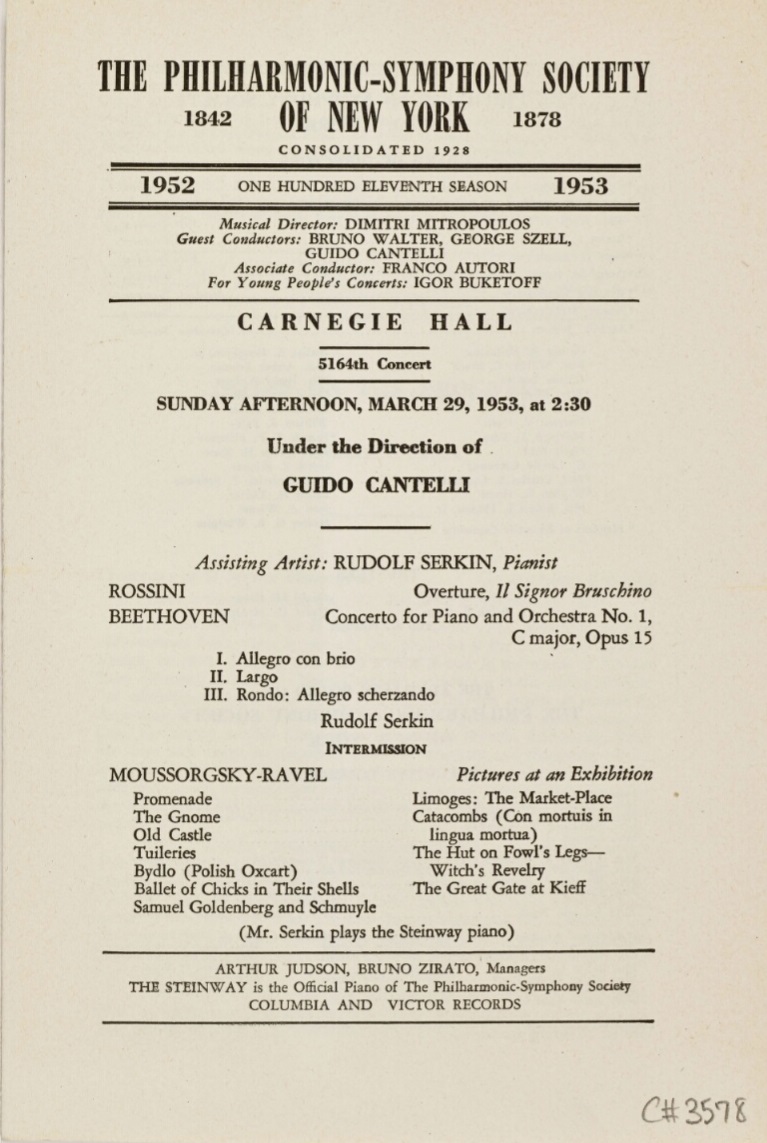
Les Tableaux d’une Exposition de Moussorgski, c’est une des œuvres que Cantelli a le plus dirigées. Outre deux concerts (22 janvier 1951, 27 février 1952) et un enregistrement officiel avec le NBC SO, deux concerts avec le Boston SO (6 et 7 février 1953), et trois avec le Philharmonia Orchestra (21 et 23 octobre 1952 à Londres et 11 septembre 1954 à Edinburgh), c’est avec le New York Philharmonic (NYPO) que l’on trouve le plus grand nombre d’exécutions dont douze à New-York (24-27 janvier 1952; 25-27 et 29 mars 1953; 13, 14, 16 janvier et 19 mars 1955) et onze en tournée entre le 20 avril et le 21 mai 1955 d’une part, et entre le 7 et le 25 septembre 1955 d’autre part.
Le présent enregistrement reflète la deuxième partie du concert du 29 mars 1953 dont la première partie (Rossini Il Signor Bruschino Ouv. et Beethoven Concerto n°1 Op. 15 avec Rudolf Serkin) est déjà disponible sur le présent blog*.
Pour ces ‘Tableaux’, tant l’interprétation, beaucoup plus expressive, que la prise de son, sont supérieures à celles du concert du 27 janvier 1952 (Coffret Music & Arts CD-1056).
Dans son article dans la revue ‘Musical America’ sur cette série de concerts de fin mars 1953, Ronald Eyer, après avoir remarqué que Cantelli dirigeait les Tableaux de Moussorgski avec un dynamisme et un sens du style qui les faisait sonner comme autant de chefs d’œuvre a proposé l’explication suivante: ‘C’est peut-être le secret du génie de Mr. Cantelli: il aborde tout comme s’il s’agissait du plus grand morceau de musique jamais écrit’.
*Rossini Il Signor Bruschino Beethoven Concerto n°1 Op. 15
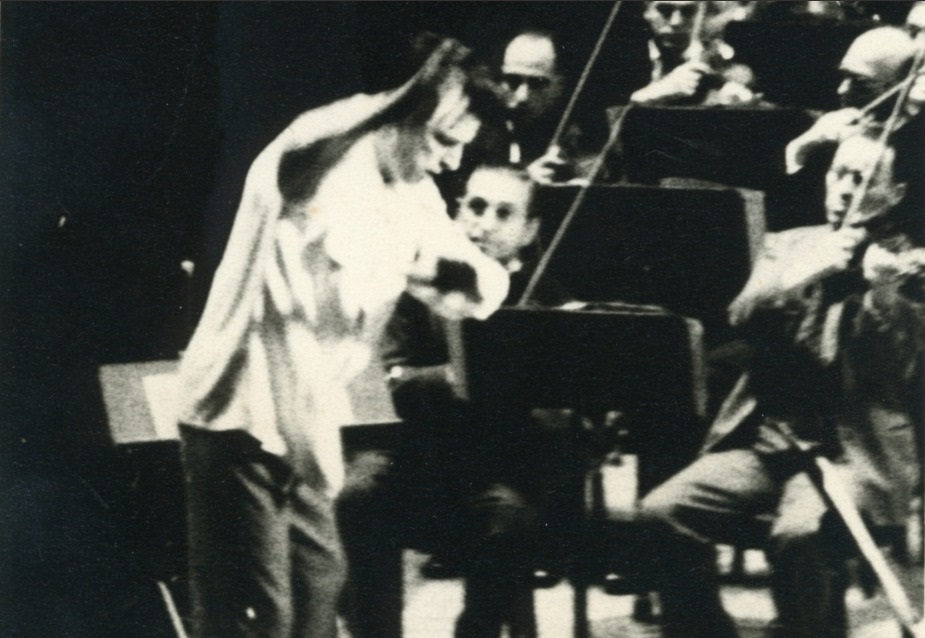
Mussorgsky’s Pictures at an Exhibition is one of the works Cantelli conducted the most. In addition to two concerts (January 22, 1951, February 27, 1952) and an official recording with the NBC SO, two concerts with the Boston SO (February 6 and 7, 1953), and three with the Philharmonia Orchestra (October 21 and 23, 1952 in London and September 11, 1954 in Edinburgh), it is with the New York Philharmonic (NYPO) that we find the greatest number of performances, including twelve in New York (January 24-27, 1952; 25-27 and 29 March 1953; 13, 14, 16 January and 19 March 1955) and eleven on tour between 20 April and 21 May 1955 on the one hand, and between 7 and 25 September 1955 on the other hand.
The present recording reflects the second part of the concert of March 29, 1953, the first part of which (Rossini Il Signor Bruschino Ouv. and Beethoven Concerto No. 1 Op. 15 with Rudolf Serkin) is already available on this blog.
For these ‘Pictures’, Both the interpretation, much more expressive, and the sound recording, are superior to those of the January 27, 1952 concert available in the Music & Arts Boxset CD-1056.
In his review in ‘Musical America’ of this series of end of March 1953 concerts, Ronald Eyer, after having remarked that Cantelli played the Moussorgsky Pictures with a dynamism and a sense of style that made them sound as momentous as masterpieces, attempted the following explanation: ‘This is perhaps the secret of Mr. Cantelli’s genius: he approaches everything as though it were the greatest piece of music ever written’.
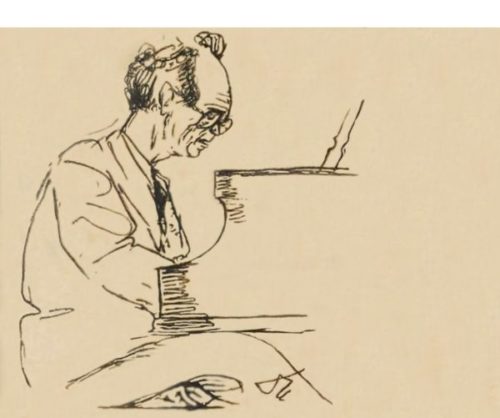
Rudolf Serkin Steinway piano – Guido Cantelli New York Philharmonic (NYPO)
Mozart Concerto n°20 K. 466 (Cadenzas: Beethoven) – Carnegie Hall March 27, 1953
Beethoven Concerto n°1 Op.15 (Cadenza: Beethoven Version III) – Carnegie Hall March 29, 1953
Source: Bande / Tape – 19 cm/s / 7.5 ips
L’invitation de nombreux solistes faisait partie intégrante de la politique des programmes du New York Philharmonic (NYPO). Cantelli a commencé à diriger le NYPO en janvier 1952, et très vite, un nombre appréciable de grands pianistes se sont produits avec lui: successivement de 1952 à 1956, Rudolf Firkušný, Nicole Henriot-Schweitzer, Claudio Arrau, Rudolf Serkin, Robert Casadesus, Walter Gieseking et Wilhelm Backhaus, et une série d’enregistrements radiophoniques nous permet d’apprécier ses qualités exceptionnelles en tant que partenaire, bien plus qu’accompagnateur.
Rudolf Serkin a fêté son cinquantième anniversaire le 28 mars 1953. Avec Guido Cantelli et le NYPO, il a joué les 26 et 27 le Concerto n°20 K.466 de Mozart et le 29, le Concerto n°1 Op.15 de Beethoven. Le jour même de son anniversaire, il a répété le concerto de Beethoven avec l’orchestre.
D’habitude, la Radio ne retransmet que le concert du dimanche dont le programme, comme ici, diffère de ceux qui ont été joués au cours de la semaine. Nous avons cependant la chance d’avoir un enregistrement du concerto de Mozart joué le vendredi 27.
Les critiques musicaux new-yorkais se sont accordés pour trouver mémorable l’interprétation par Serkin du concerto de Mozart et pour louer la direction de Cantelli.
Harris Goldsmith, qui a assisté au concert du 29 alors qu’il était encore étudiant en piano, a relaté bien plus tard à quel point l’interprétation beethovénienne de Serkin, portée par les tempi rapides et fougueux de Cantelli, qui lui rappelaient ceux de Toscanini (avec Ania Dorfmann), était à la fois musicale et intense.
On notera dans le largo du concerto de Beethoven la finesse du dialogue entre le piano et le clarinettiste solo du NYPO, Robert Mc Ginnis.

Inviting a large number of soloists was an integral part of the schedule of the New York Philharmonic (NYPO). Cantelli started conducting the NYPO in January 1952, and very soon, a significant number of great pianists performed with him: successively from 1952 to 1956, Rudolf Firkušný, Nicole Henriot-Schweitzer, Claudio Arrau, Rudolf Serkin, Robert Casadesus, Walter Gieseking and Wilhelm Backhaus, and a series of broadcast recordings allows us to appreciate his exceptional qualities as a partner, rather than an accompanist.
Rudolf Serkin’s fiftieth birthday was on March 28, 1953. With Guido Cantelli and the NYPO, he played Mozart’s Concerto n°20 K.466 on the 26 and 27, and on the 29, Beethoven’s Concerto n°1 Op.15. On the birthday itself, he rehearsed the Beethoven concerto with the orchestra.
Usually, the Radio broadcasts only the Sunday concert whose program, as here, is different from those that have been played during the week. We are however lucky to have a recording of the Mozart’s concerto played on the Friday 27.
New York music critics agreed to find Serkin’s performance of the Mozart concerto memorable and to praise Cantelli’s conducting.
Harris Goldsmith, who attended the concert on the 29 when he was still a piano student, remembered many years later to what extend Serkin’s Beethoven performance, uplifted by Cantelli’s fast and fiery tempi, which reminded him of Toscanini’s (with Ania Dorfmann), was both musical and intense.
Note in the largo of the Beethoven’s concerto the delicacy of the dialog between the piano and the solo clarinettist of the NYPO, Robert Mc Ginnis.



